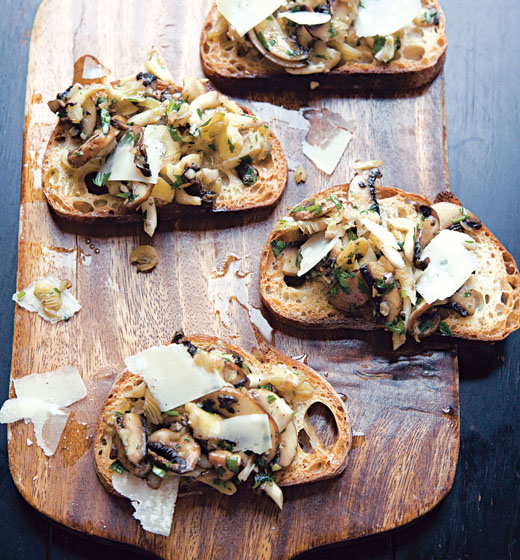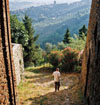Mushroom and Herb Crostini
Crostini con Funghi
Simple, satisfying crostini like these are among the many dishes prepared by saveur contributor Beth Elon and her neighbors for a feast held each summer in their Tuscan town of Buggiano. We like the earthy flavor of cremini mushrooms in this classic antipasto, but you can use any variety of mushroom you like.
8 oz. mixed mushrooms, such as cremini, oyster, and button, stemmed and thinly sliced
7 tbsp. extra-virgin olive oil
3 tbsp. minced flat-leaf parsley
1 tbsp. fresh lemon juice
1 clove garlic, minced Kosher salt and freshly ground black pepper, to taste
8 slices country-style Italian bread, such as ciabatta Small wedge of Parmigiano-Reggiano
Serves 4
1. Heat the oven to 475°F. Toss together the mushrooms, 4 tbsp. oil, parsley, lemon juice, and garlic in a medium bowl. Season with salt and pepper and let sit at room temperature until the mushrooms have softened, about 20 minutes.
2. Put the bread slices on a baking sheet and brush with the remaining oil. Bake bread slices until golden brown, about 10 minutes. Let cool slightly, then spoon the mushroom mixture over the bread. Using a peeler, thinly slice strips of Parmigiano to garnish the crostini.
COOKING NOTE The best way to clean mushrooms—rinse or soak in water, or wipe each mushroom with a damp cloth to avoid its taking in water—has long been a subject of debate. It took scientific proof to satisfy us once and for all. In an experiment described in the book The Curious Cook, author Harold McGee demonstrated that after soaking for five minutes, a button mushroom absorbs only one-sixteenth of a teaspoon of water. A speedy rinse, McGee concludes, results in virtually no water retention. The myth of the soggy mushroom, it turns out, just doesn’t hold water.
Alfresco Feast
One of the joys of living in Tuscany is that locals love a good party, which explains why many towns frequently hold communal meals and sagre—outdoor festivals that celebrate the harvest of a cherished local food. Such gatherings are a testament to Tuscans’ abiding attachment to the seasonal rituals that are the foundation of rural life here. In Buggiano (pictured), where I live, we have several alfresco feasts each year, but our summertime cena (the name simply means dinner) is the most special because all of the food is prepared by local home cooks. The dinner, which is held in our main piazza, is a lavish potluck: there are platters of antipasti, including crostini topped with seasonal ingredients, and Herbed Tomato Tarts. There are pastas, and a main dish of roast pork, fragrant with garlic and herbs. And for dessert: a spread of pastries, followed by glasses of locally made limoncello, and dancing that goes on late into the night.
—Beth Elon

